
The Present and Future of Link Building OKRs: What Success Looks Like
Goals. OKRs.
Progress, motivation, productivity, success.
Ticking the “done” box. Knowing you’ve achieved it.
The sweet feeling of accomplishment.
That’s what OKRs give us link builders, link-building managers, and link-building agencies.
I’ve been in a love-hate relationship with OKRs for over a year now.
In this article, I’m going to cover OKRs for link building using real-life examples from our agency, Jolly SEO, showing how we use OKRs and how we learn from mistakes. Finally, I will share some tips for setting up your own OKRs.
Understanding OKRs: What they are and why they are important
OKR is a critical concept in business for setting, coordinating, and accomplishing goals. It has helped many companies, like Google, Amazon, Samsung, and Disney, set their priorities, create effective strategies, and ultimately achieve their objectives. And this concept can be applied to your link-building tactics.
But before that, let's have a little trip down memory lane.
The Intel CEO, Andrew Grove, conceptualized the idea of OKR back in the 1970s. He was the one who taught this concept to one of the most successful salespeople in the world, John Doerr. Doerr later introduced this business framework to Google's founders, Larry Page and Sergey Brin. And the rest is history.
Today, businesses of all sizes rely heavily on OKRs. Fortune 500 companies and even small and mid-sized enterprises (SMEs) apply this concept when launching projects and running campaigns.
OKRs have long been proven effective in aligning operational strategies with core objectives. And for the most part, they have helped organizations yield their desired results!
The importance of setting OKRs for link-building campaigns
The truth is that OKR benefits are multifold. Here’s why they are vital to your SEO and business success:
Clear Goals: Goals are vital in every business as they are the reasons your organization exists. However, you must be very clear and specific with your objectives for your link-building campaigns. Setting OKRs can help you clearly define your goals so that no money, time, or effort gets wasted.
Aligned Strategies: Setting goals is one thing; aligning your tactics with them is another. Establishing OKRs lets you align your various strategies with your primary objectives. As they say, the means to an end is crucial to achieving your goals
Ensured Commitment: As mentioned, OKRs can be organizational and personal. They require setting departmental and individual goals, which means getting everyone to participate and contribute. As a result, they can guarantee the commitment of all stakeholders involved in your link-building campaigns.
Seamless Collaboration: Personal goals guide your employees in accomplishing their link-building tasks. However, aligning their individual targets with your organizational objectives fosters effective collaboration. Setting OKRs guarantees a cohesive unit where everyone works towards common business goals.
Effective Monitoring: Defining goals and setting key performance indicators (KPIs) requires performance monitoring. Setting OKRs compels you to monitor and measure your SEO performance. Doing so gives you a higher chance of success in your link-building campaigns.
Process Optimization: In line with performance monitoring, OKRs aid you in streamlining your processes. How? They let you align your link-building strategies with your objectives, address inefficiencies, and improve your processes. Ultimately, they help you meet your overall objectives.
Desired Results: The ultimate goal of setting OKRs is to achieve your desired outcomes. With clear objectives, aligned strategies, and laser-focused results, you have a higher chance to succeed in your link-building efforts.
Types of OKRs
OKRs come in two basic types:
Departmental/Company OKRs: They focus on the primary goals and desired outcomes of a particular department within an organization. With these, you usually align your department's strategies with your company's primary objectives. For example, at Jolly SEO, we have a departmental goal of maintaining the percentage of unbillable products under 10% of total production order on a monthly basis.
Individual OKRs Refer to employees' personal goals and targets in a team or department. These employees must align their work strategies with the overall departmental and organizational objectives. Based on the departmental OKR above, an individual OKR of the link building team manager (that would be me) is to ensure that the team has a clearly defined process of 1) preventing and 2) converting unbillable product to billable.
I'll provide real-life examples to put things into perspective and practice. Learn from the OKRs we've set for our white hat link building team below.
Current OKRs of Jolly SEO's link building team
We launched the White Hat Linkbuilding service in February 2022. Since then, we’ve come a long way of building a team from scratch, setting up the processes, and ensuring regular link production.
Since day one of service, we’ve been working on developing priority OKRs that will help us grow and improve the quality of our product.
Below, I’ll share examples of company and individual OKRs and explain how they contributed to the team’s success.
Company OKRs
Guarantee a consistent link production

In the screenshot above, you can see one of our top priority OKRs, which is to ensure that we close our client link orders at 95%. In simple words, if we have an order to build 100 links per month, this OKR ensures that we build at least 95 links for that goal every month.
It goes without saying that this is the top priority OKR for any team who is providing link building services to their clients. And this is something we’ve started tracking since February 2022, when the service was established.
Every month, we’ve calculated what % of links we’ve built from the total number of links we were supposed to create, according to our monthly link order (see screenshot below).
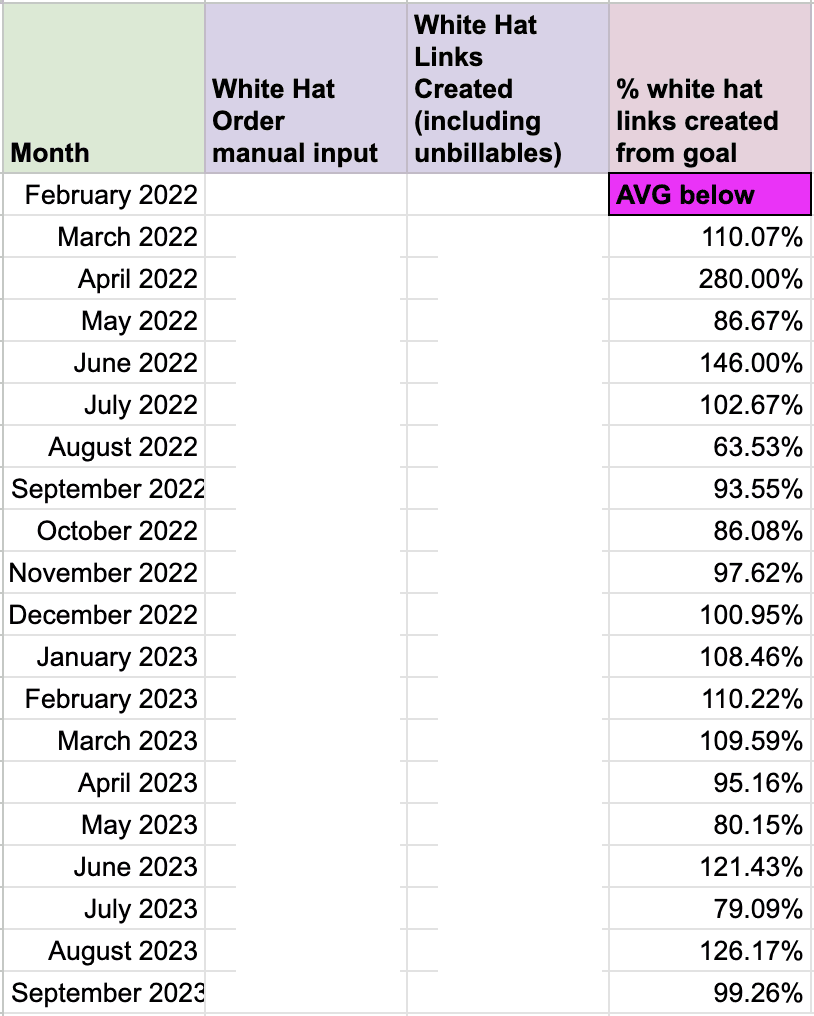
Team members who execute link building campaigns have their individual OKRs that are directly connected to this primary departmental OKR. We’ll discuss how these individual OKRs contribute to the fulfillment of our company OKR.
2. Keep the % of unbillable products under 10%

At the Jolly SEO team, an unbillable product is a link that cannot be billed for. This may be a nofollow link, a link to social media accounts, or a simple mention of a client link in the text without an actual hyperlink.
These links are integral parts of every link building process, and every link builder here will know what I mean.
Sometimes, websites change their linking policies. Sometimes, they just change their minds and won’t add links. In most cases, this is something that is not under our control. But we can still try and do something about it.
We’ve introduced this OKR to the team just recently and created SOPs for 1) preventing and 2) managing unbillable products. This is how our numbers looked in August and September 2023:

As you can see, we haven’t reached the goal of keeping unbillables under 10%, but we’re on the right track.
Ensuring the first link the client gets has a DA of at least 70 (OKRs in progress)
In addition to OKRs directly tied to link production, we are constantly working on increasing the quality of our product and testing different hypotheses.
Whenever we have a new client, we want to give them the first link on a website with a Domain Authority (DA) of at least 70. The logic behind this hypothesis is that when we have a new client, we want to give them a very good first impression by providing a strong link at the very beginning of their service with us.
Why a DA of 70?
At Jolly SEO, the minimum Domain Authority of links we build is 50. Getting a link on a website with a Domain Authority of at least 70 is not easy, which makes such links unique and impressive.
So what? What is the purpose of this?
The purpose of building a link on a highly authoritative website lies in the hypothesis that if we impress the client from the start, they will spend more time as a client of ours.
However, before you set up a new OKR and request the team to follow it, we have to test it using the data we have at hand from the past. One of the ways to test the hypothesis above is to use the Pearson Correlation Coefficient.
The Pearson Correlation Coefficient allows us to measure the connection and strength between two variables. Two variables we want to test for connection are:
How many days has the client spent using our service
What was the Domain Authority of the first link we got to that client?
Using available company data, we’ve found a “weak negative” correlation between the days the client has been with us and the Domain Authority of the first link.
A “weak negative” correlation means that when variable A increases, variable B decreases, but in an unreliable manner.
We got this by testing whether there was any correlation between the time the client has spent with Jolly SEO and the Domain Authority of the first link we built for that client.
In the screenshot below, you can see what this “weak negative” correlation looks like.
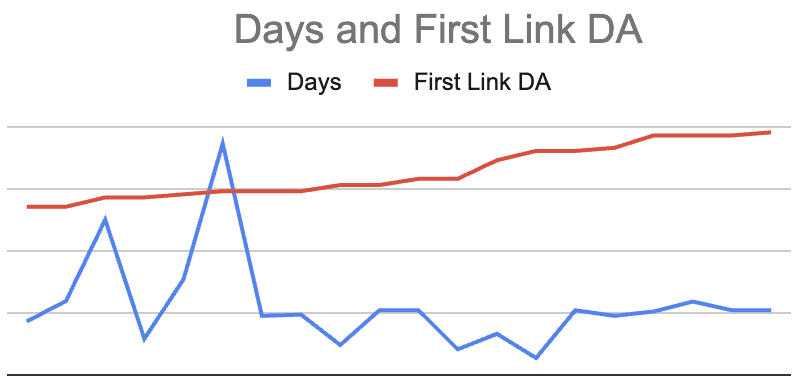
However, correlation doesn’t mean causation, which means we’re still working on this one.
Individual OKRs
Our white hat link building team consists of outreach managers, who execute and plan outreach; prospectors who help find prospects for campaigns and personalize them; content writers, who ensure we send out only quality content whenever we are working with guest writers.
Below, I’ll show two OKRs for outreach managers and demonstrate how they align with the departmental OKRs we’ve discussed above.
1. Monthly link target
Every outreach manager on the team has an individual monthly link target. This target is based on a few factors. For example, 1) how many hours per week they work (part-time or full-time) and 2) their level of expertise.
This monthly target allows the team to estimate our monthly link production and see if we’re on track with our primary departmental OKR.
However, relying on these estimated numbers is not the only way to ensure consistent production. If you’ve been in link building for as long as I’ve been, you know that sometimes the only thing that works is praying to link building gods and hoping that the links will come.
I’m joking (but maybe not).
2. Number of pitches sent
Another OKR we plan to introduce on an individual level is the minimum number of pitches that should be sent to close the link target.
We have identified how many websites we should pitch to on a monthly basis to complete our total production goals.
We are able to calculate this by counting the number of pitches we send on a monthly basis vs. the number of links we build. For example, the number of pitches sent is considered ideal when we manage to close our link order when sending out a particular number of pitches. This way, we are able to identify the number of pitches we have to send to reach our goals.
Here is an example:
We have an order of 100 links per month, and we need to send out 200 pitches to build 100 links (this is a hypothetical number)
By doing simple math, we can identify that when we have a link order of 200 links per month, we’ll have to send out 400 pitches.
This number is further divided between our outreach managers so everyone is aware of their personal pitches per month goal.
Tips on setting up your OKRs
I feel this article won’t be complete without mentioning my personal tips for setting up your OKRs.
The thing is — OKRs are attractive. Our brains love tracking things and seeing the progress. It motivates us, challenges us, and shows us that we’ve achieved something.
But the trick is that it may be easy to enjoy creating OKRs for the sake of having OKRs and not improving your productivity.
I know this from my personal experience. I love tracking stuff. I love seeing numbers and percentages and keeping track of progress.
However, as mentioned in the previous paragraph, all your strategies should be aligned. You may not need to ensure that the first link you receive is above a DA of 70+ if the data does not support it. But, where is the guarantee you’re analyzing your data right? Well, that’s another question.
Anyway, here are a few tips for setting up your own OKRs:
Try them one by one.
I highly recommend coming up with one big OKR you want to achieve and then building all others as a part of it.
For example, if you want to have an average DA of 70 for all of your backlinks, your sub-OKRs should be something like 1) pitching more high DA websites (which may lead to more sub-OKRs, trust me), 2) increasing the minimum DA of the websites you’re pitching to.
Keep it cool and remember about factors you cannot control, such as holidays, low seasons, people going on vacations, your team taking leave, etc.
All of this impacts our productivity. But it’s important to understand that we’re humans, and OKRs are just numbers at the very end.
Make it SMART
It may sound cliche, but every OKR you work on should be specific, measurable, attainable, relevant, and time-bound. The more specific you get, the better.
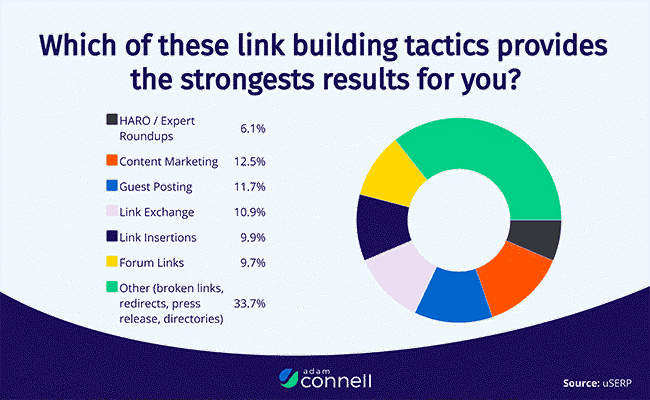
Image Source: https://adamconnell.me/link-building-statistics/
It's crucial, however, to align your OKR initiatives with current and future trends for your link-building campaigns. Below are some of the most important trends you should know and align your strategies with:
1. Wearing a white hat for ethics and compliance
Link building has long been proven effective for boosting your SEO campaigns. However, this rule of thumb remains true to this day and in the future: wear the white hat as a digital marketer.
As such, your OKRs should always revolve around white hat practices. As they put it, don't buy links; earn them!
To understand further, distinguish white hat link building from black and gray hat practices. Look at the table below:

2. The emphasis on link quality over quantity
When setting OKRs for your link-building campaigns, it's easy to focus on link quantity over link quality.
But as search engine algorithms evolve, you must put emphasis more on earning relevant and valuable backlinks than obtaining a large number of links.
As early as now, keep up with this link-building trend. Learn their differences in the table below:
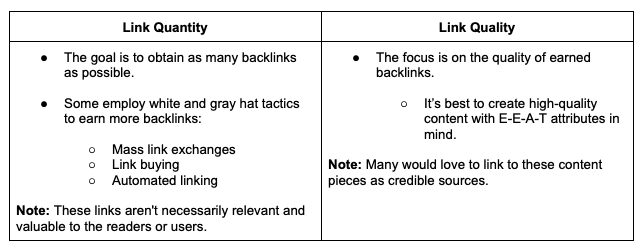
3. Focus on E-E-A-T for content creation and link building
Did you know that another E has been added to E-E-A-T? In the world of SEO, this acronym stands for experience, expertise, authority, and trust.
Search engine algorithms are rapidly evolving and are capable of analyzing the abovementioned attributes when ranking your content.
So when setting OKRs for your content creation and link-building processes, keep E-E-A-T in mind:
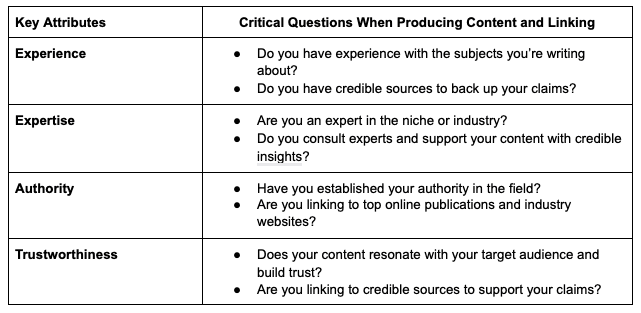
4. The diversification of link-building strategies
When implementing link-building campaigns, you might think of creating high-quality content in hopes that people will link to your webpage. However, there’s more to it than meets the eye.
As the SEO landscape has become more competitive than ever before, it’s vital to diversify your link-building strategies. You must be strategic in your approach by employing white hat practices. That way, you have more chances of earning high-quality backlinks for your website.
Below are some link-building tactics you may consider implementing:
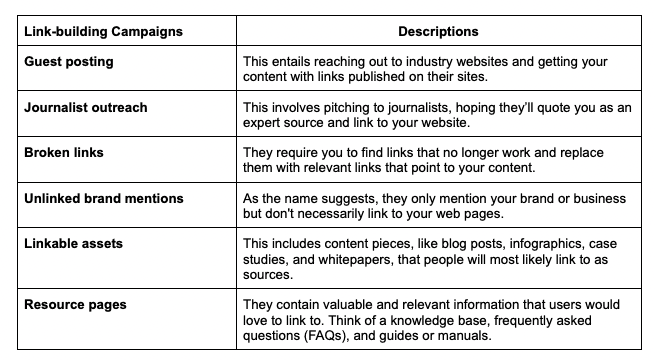
Final words
Link building plays a crucial role in your SEO campaigns and overall business success. While it currently boosts your online visibility and website traffic, it can provide your business with customer engagement, lead-generating, and sales-converting opportunities.
Setting OKRs can help you implement the best link-building strategies and achieve your SEO goals. As such, sit down and brainstorm with your team to create OKRs, start with organizational, and then break them down individually.
Ultimately, strive to meet your primary objectives and attain the desired results for your overall SEO success.
I have forgotten to mention the most important thing…
Have fun!
The author's views are entirely their own (excluding the unlikely event of hypnosis) and may not always reflect the views of Moz.



